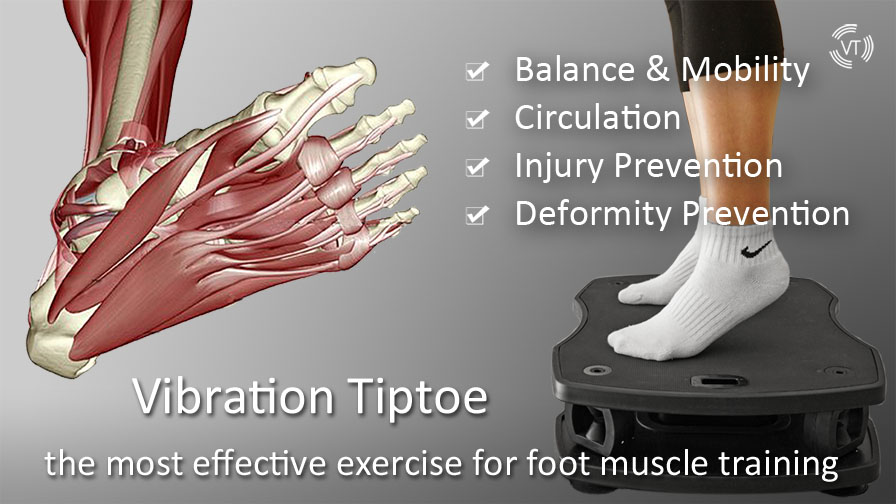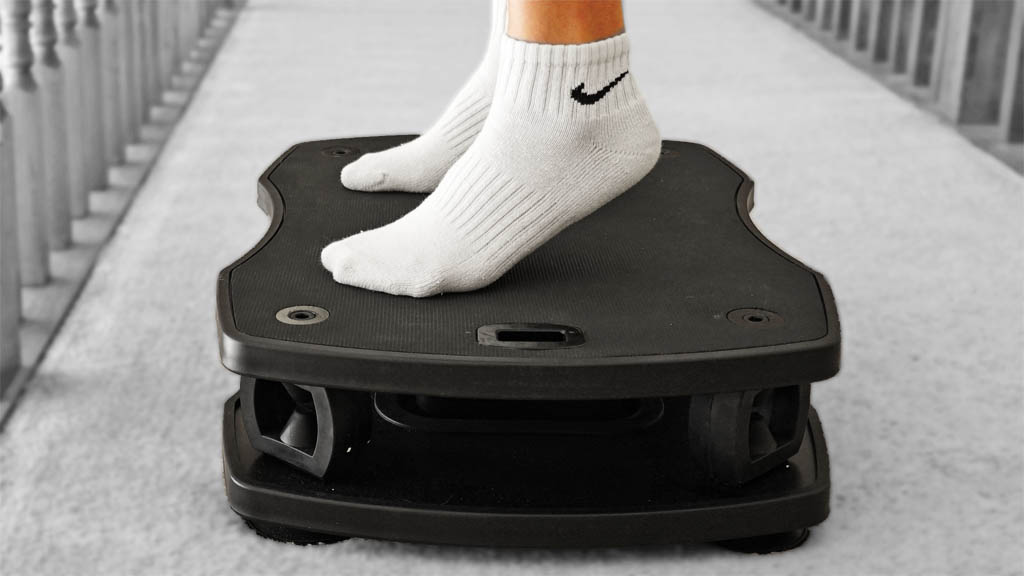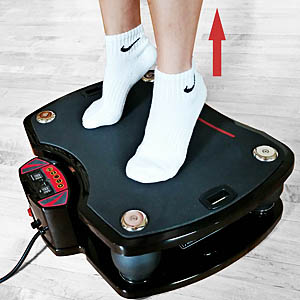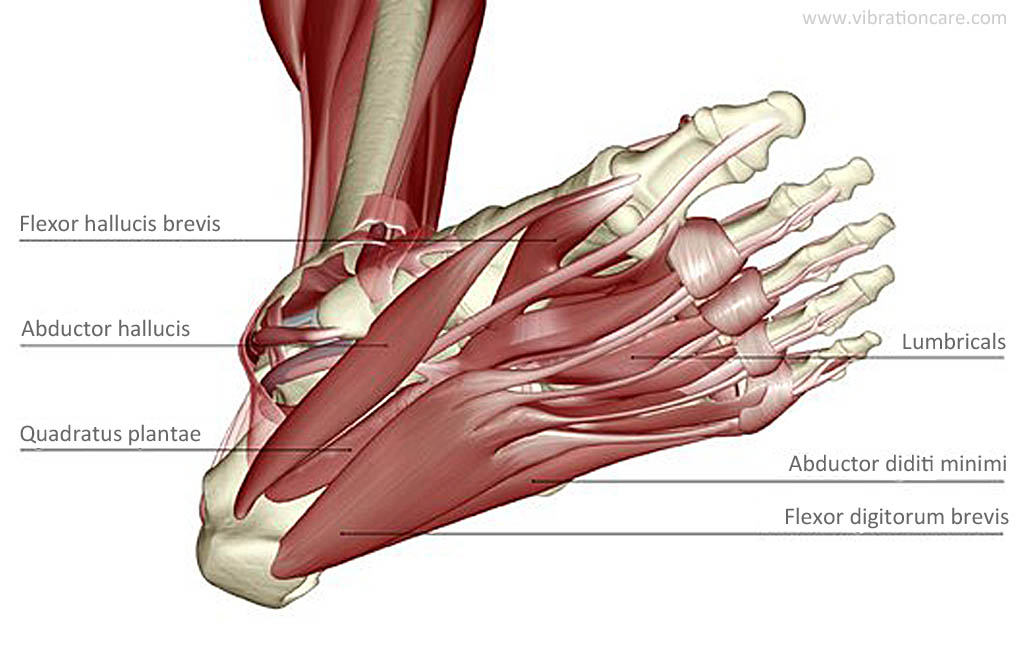
Foot Muscle Vibration Training
Foot muscle training on a linear vibration plate is revolutionary,
Feet are incredibly complex devices. A foot has 26 bone, 33 joints, 20 muscles and many tendons and ligaments connecting muscle to bone and bone to bone. Foot bones count comprises over 20% of the bone count of our entire body.
Foot muscle exercise is often overlooked.
Regular walk mainly exercises lower leg muscles, but not much for the muscles in the foot.
The strength and functionality of the foot muscles are essential for our balance, stability and maneuverability.
Tiptoe and calf raise on vibration plate are the most practical way to enhance foot muscles and lower leg muscles.
Our complex foot muscles make us the only creature that walks upright.

Oh wait ...
penguins walk upright too, but you don’t want to walk like a penguin, do you?
- Benefit of Foot Muscle Exercise
- Foot Exercise on Vibration Plate
- Differences Between Tiptoe and Calf Raise
- Knowledge - Muscles Responsible for Foot Functions
- Insufficient Exercise for Foot Muscles
- Exercise Tips
Benefit of Foot Exercise
- Strong foot muscles increase your strength, mobility, flexibility, and the ability to prevent injury.
- For senior people, enhanced foot muscles help balance, reduce the risk of falling.
- Improved foot muscle strength help resist flatfoot development and other foot deformities.
- Foot circulation improvement is the cure for many hard-to-treat foot disorders, such as lymphedema, infection, code foot, and neuropathy.
Our complex feet allow our ancestors to survive the harsh nature.
Nowadays, however, we all wear comfortable shoes and mostly walk on a flat ground. We predominately use our lower leg muscles to lift our feet, much less using our foot muscles - especially the plantar muscles and intrinsic muscles.
Without exercise, these important muscles will loss their strength and responsiveness, compromising our stability, balance and maneuverability.

Ergonomically designed footgears like sneakers provide good support and protection for your feet. However, these shoes also restrict foot muscle flex.
Additionally, sneakers' thick shock-absorb heel soles encourage you to walk mainly on your heels, which is a poor foot posture, you using your foot muscles even less.
Without the needed exercise, your foot muscles become weak.
If you need to walk or stand for an extended period of time, or to perform certain sports, sneakers can prevent your foot muscles from over-fatigue or injury.
After a whole day wearing the sneakers, you need to have some time to walk barefooted to exercise your foot muscles, on every digit.
You can perform vibration exercise for enhanced foot muscle training, and efficient recovering from fatigue.
Don't forget that the most ergonomically designed footgear is your own foot, its structure and integrated components. You want to maintain its strength and functionality.
If your foot muscles, the connecting tendons and ligaments are weak, your foot bones can shift, causing foot deformity,
Foot Exercises on Vibration Plate
Health professionals share many great foot exercise poses on the internet. Some of those exercise poses can be perfectly duplicated on a vibration plate for enhanced efficiency and effectiveness.

Calf raise and tiptoe best utilize the advantage of a linear vibration plate.
Because your feet are directly pressed on the vibration plate, the vibration from the machine is all transmitted to your feet and up to the calves.
The rapidly repeated intensive muscle contraction induced by vibration adds great dynamics to exercise your foot and lower leg muscles, allowing you to achieve much enhanced results.
Calf raise and tiptoe share some similarities. They both exercise the lower leg muscles and the foot muscles.
It is worth to know that these two poses target different muscle groups, so that you can work your muscles consciously.
- Calf raise concentrates more on working lower leg muscles.
- Tiptoe concentrates more on working foot muscles, which are located within the foot.
Calf raise and tiptoe are different exercises.
Differences Between Tiptoe and Calf Raise
Calf Raise
Performing calf raise, you naturally lift your heels, without purposely tense your toes. Calf raise mainly exercises the posterior leg muscles, including calf muscles.
Tiptoe

Performing tiptoe, you lift your heels and let your toes purposely press hard against the vibration platform, so that you have more body weight on your toes. Tiptoe mainly exercises your plantar muscles and intrinsic muscles.
Stretch and spread your toes out and let your body weight evenly distributes on every toe. This way you have better balance and exercise many foot muscles.
In tiptoe pose, your toes are in horizontal position, NOT like ballerina tiptoe.
Knowledge - Muscles Responsible for Foot Functions
Lower leg muscles and foot muscles are responsible for foot and ankle functions. They play different roles.
While lower leg muscles are responsible for major lift of the foot and ankle, foot muscles are responsible for stabilizing the arch and moving the individual foot digits, for balance and maneuverability.
Lower Leg Muscles
Lower leg muscles can be divided to anterior muscles and posterior muscles. These muscles are responsible for flexing and turning foot around the heel and the ankle.
Posterior muscles are the major muscles responsible for lifting the heel, overcoming the gravity when you walk.
If you walk on a flat ground, you mainly use your lower leg muscles to move your feet and ankles.
Calf raise mainly exercises posterior leg muscles, including calf muscles.
Foot Muscles
 Complex foot muscles stabilize the arch and control the digits
Complex foot muscles stabilize the arch and control the digits
Foot muscles mainly comprise of plantar muscles at the sole and intrinsic muscles contained inside the foot. These muscles are responsible for the fine motor actions of the foot, such as stabilizing the arches and moving the individual foot digits, for balance and maneuverability.
If you walk on an uneven ground, or you turn direction or do other complex foot movement, besides using your lower leg muscles to lift and move your foot, you rely on your foot muscles to adjust the movement and keep the balance.
Tiptoe mainly exercise the plantar muscles in the sole. Plantar muscles are are the major muscles in the foot.
Insufficient Exercise for Foot Muscles
Many people don't get enough exercise on foot muscles to maintain the needed strength and functionality.
As we age, we use our foot muscles less due to reduced physical activities. Regular walking helps for the lower leg muscles, but not much for the foot muscles.
Weak foot muscles compromise the balance and gait, leading to higher risk of injury and falling.
Tiptoe on a linear vibration plate is the best way to exercise our plantar muscles, suitable for different age and physical conditions.
Exercise Tips
Calf raise is easy to perform. Tiptoe is a little challenging, but more rewarding.
Stretch and spread out your toes
For tiptoe, be sure you stretch and spread out each of your toes, and press each of them firmly on the vibration plate, so that vibration can work all plantar muscles connected to each digits.
Be conscious about what muscle groups you work. You should feel calf muscles tense on calf raise, and lateral muscles at the bottom of the feet tense on tiptoe.
Barefooted
For tiptoe, you need to be barefooted on a vibration plate in order to sense and train your individual plantar muscles and intrinsic muscles to react to vibration stimulation.
Move up and down
For either calf raise or tiptoe, you can slightly move up and down to engage multiple layers of muscles from surface down.
Single foot exercise
For either calf raise or tiptoe, you can use single foot pose for more aggressive exercise for balance training.
Hold a weight
For calf raise, you can hold a pair of dumbbells to add the intensity of muscle contraction.
Close eyes
For either calf raise or tiptoe, you can close your eyes to train the instinct response of your foot muscles and lower leg muscle for enhanced balance training.
Exercise time
Depending on your physical condition, you can do a 5 to 10 minutes session alternating calf raise or tiptoe, once or twice a day.
Safety
Be sure to use a support like a handrail or a desk for balance. You don’t need to lean on the support. Use it only when you are out of balance to prevent falling.
- Jay Tang
- About
-
Interpreting life science from an engineering perspective.
Featured Posts:
